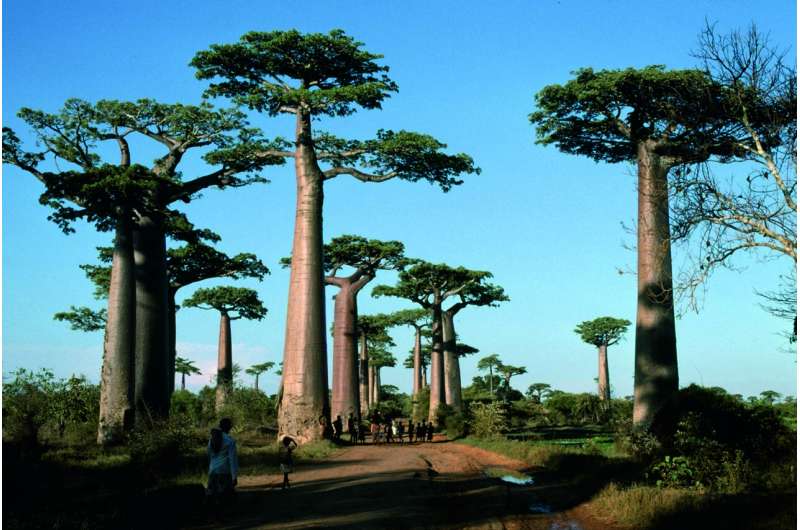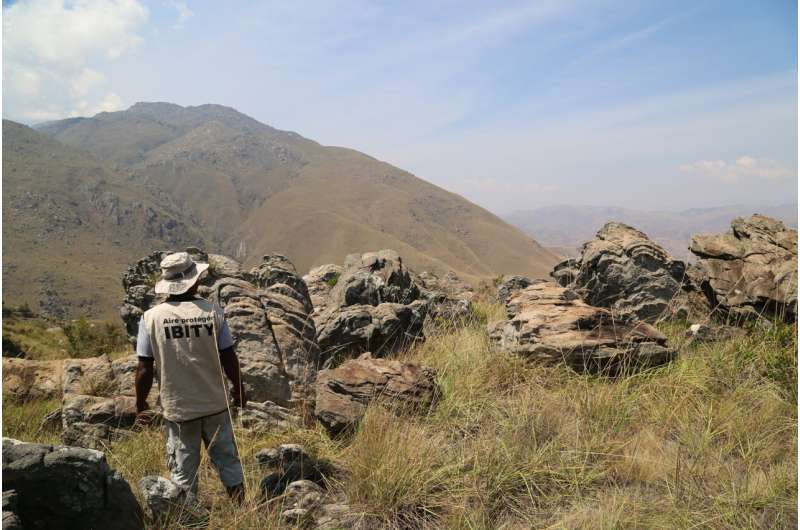New research prompts urgent call to protect Madagascar's unique biodiversity before it's too late

In two new papers published today, December 1, in Science, researchers from the Royal Botanic Gardens, Kew and partners from 50 global organizations have undertaken a major review of Madagascar's extraordinary biodiversity. Bringing together the most up to date resources and using cutting-edge techniques to predict conservation status, the team evaluated the threats facing terrestrial and freshwater biodiversity and looked at future opportunities for conservation and restoration.
Madagascar is one of the world's foremost biodiversity hotspots, with a unique assemblage of plants, animals, and fungi, the majority of which evolved on the island and occur nowhere else. And yet these papers highlight that there is still much to learn, particularly for groups such as fungi and invertebrates, where current scientific species descriptions represent a small fraction of the full diversity present. Despite species descriptions accelerating in recent years, there is much to do to scientifically describe the full range of Malagasy species and to understand their past, present and future.
Understanding the origins, evolution, current distribution, and uses of Madagascar's extraordinary biodiversity in this way is crucial to highlighting its global importance and guiding urgent conservation efforts. It is estimated that there are 11,516 described species of native Malagasy vascular plants, of which a staggering 82% are endemic. Among the 1,314 species of native terrestrial and freshwater vertebrates, the figure is even higher—with 90% endemism overall.
This unique diversity is in grave danger. The research team compiled available IUCN assessment data on plants and vertebrates, and used machine learning to predict the extinction risks for plant species lacking assessments. Only a third of all Malagasy plant species (just under half of native species) have been formally assessed, and yet researchers found that Madagascar is home to a disproportionately high number of Evolutionarily Distinct and Globally Endangered species and that the number of threatened ferns and their relatives may have been underestimated.
Their analyses showed that overexploitation (the direct hunting and harvesting of species) and unsustainable agricultural practices affect 62.1% and 56.8% of vertebrate species, respectively, and each affect nearly 90% of all plant species. They conclude the current knowledge on Madagascar's biodiversity and its decline indicates an urgent need for action.
Professor Alexandre Antonelli, Director of Science at Royal Botanic Gardens, Kew says, "Nature is our biggest asset in the fight against climate change and food insecurity. Yet, we've degraded every ecosystem on this planet to a fraction of their past extent, killing off large numbers of species and putting many more at risk. Madagascar is a case in point: its biodiversity is as unique as it is threatened. We wanted to showcase this global hotspot and outline the actions required to reset our relationship with nature and ensure its protection and sustainable use. The key solution is addressing the needs of people."
Currently, protected areas cover 10.4% of Madagascar and are relatively well-placed to capture the island nation's biodiversity. The team found that the network provides good coverage of the major habitats, particularly mangroves, spiny forest, humid forest, and tapia, but that subhumid forest and grassland-woodland mosaic have very low areas under protection (5.7% and 1.8% respectively). Nevertheless, 79.6% of threatened plants and 97.7% of threatened vertebrates occur within at least one protected area.
Complementary to this, ex situ collections hold 18% of vertebrate species and 23% of plant species. Maintaining and improving the quality of protection in these areas, along with effective ex situ conservation, such as seed banks and breeding and reintroduction programs, and integrated community programs, will be the key to success.

Madagascar's rich biodiversity, particularly its diverse flora, has provided many opportunities for human utilization and there are many more useful properties waiting to be explored. Of the 40,283 plant species documented to be used by humans worldwide, 1,916 (5%) are found on Madagascar. Of these, 1,596 are native and endemic to the island. The challenge is to find a balance between use of biodiversity and conserving the integrity of protected areas.
The majority of Madagascar's over 28 million inhabitants live outside of, but often very close to, protected areas. These communities face challenges connected to widespread poverty, which itself is related to degradation of natural capital in the landscape, limited access to formal education, health care and regulatory issues including land tenure.
Dr. Hélène Ralimanana, Kew Madagascar Conservation Center, Operations Team Leader, said, "The government has made important progress in extending protected areas. Great effort has also been made to support Madagascar's richness, such as the seed banking program and conservation of living collections in zoos and botanical gardens. Despite these achievements, the landscape has dramatically changed during the last decade. It is unthinkable that we will lose this richness if no urgent actions are taken.
"We must look for urgent economic and social solutions to face the dependence on natural resources. It is the responsibility of everyone, including policymakers, local communities, civil societies."
Madagascar has made important progress towards achieving international climate, biodiversity, and sustainable development goals; providing a foundation on which to build in the coming decades. The researchers frame biodiversity as the greatest opportunity and most valuable asset for Madagascar's future development—a key resource for the sustainable future and well-being of its citizens.
They propose five opportunities for action to further conservation in a just and equitable way:
- Investment in conservation and restoration must be based on evidence and effectiveness, rather than simplistic area-based metrics, and tailored to meet future challenges through inclusive solutions.
- Expanded biodiversity monitoring, including increased dataset production and availability, is key to safeguarding Madagascar's most valuable natural assets.
- Improving the effectiveness of existing protected areas, for example through community engagement, training, and income opportunities, is more important than creating new ones.
- Conservation and restoration should not focus solely on the protected areas network but should also include the surrounding landscapes and communities.
- Conservation actions must address the root causes of biodiversity loss, including poverty and food insecurity.
This body of research and the evidence collated makes a clear case for Madagascar as one of the world's foremost conservation priorities. The researchers have presented a clearer and more detailed understanding than ever before of past and present Malagasy diversity, its current distribution and the threats it faces. The underlying data is the product of decades of research from Malagasy and international biologists and the authors argue the gathering and analysis of data must continue and accelerate if we are to safeguard Madagascar's unique biota.
More information: Alexandre Antonelli et al, Madagascar's extraordinary biodiversity: Evolution, distribution, and use, Science (2022). DOI: 10.1126/science.abf0869. www.science.org/doi/10.1126/science.abf0869
Hélène Ralimanana et al, Madagascar's extraordinary biodiversity: Threats and opportunities, Science (2022). DOI: 10.1126/science.adf1466. www.science.org/doi/10.1126/science.adf1466
Journal information: Science
Provided by Royal Botanic Gardens, Kew




















